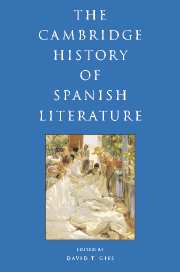Book contents
- Frontmatter
- I INTRODUCTION
- II HISTORY AND CANONICITY
- III THE MEDIEVAL PERIOD
- IV EARLY MODERN SPAIN: RENAISSANCE AND BAROQUE
- V THE ENLIGHTENMENT AND NEOCLASSICISM
- VI THE FORGING OF A NATION: THE NINETEENTH CENTURY
- VII THE MODERN, MODERNISMO, AND THE TURN OF THE CENTURY
- VIII TWENTIETH-CENTURY SPAIN AND THE CIVIL WAR
- 41 Poetry between 1920 and 1940
- 42 Prose: early twentieth century
- 43 The commercial stage, 1900–1936
- 44 Theatrical reform and renewal, 1900–1936
- 45 Federico García Lorca
- IX IN AND OUT OF FRANCO SPAIN
- X POST-FRANCO SPANISH LITERATURE AND FILM
- Bibliography
- Index
- References
43 - The commercial stage, 1900–1936
from VIII - TWENTIETH-CENTURY SPAIN AND THE CIVIL WAR
Published online by Cambridge University Press: 28 March 2008
- Frontmatter
- I INTRODUCTION
- II HISTORY AND CANONICITY
- III THE MEDIEVAL PERIOD
- IV EARLY MODERN SPAIN: RENAISSANCE AND BAROQUE
- V THE ENLIGHTENMENT AND NEOCLASSICISM
- VI THE FORGING OF A NATION: THE NINETEENTH CENTURY
- VII THE MODERN, MODERNISMO, AND THE TURN OF THE CENTURY
- VIII TWENTIETH-CENTURY SPAIN AND THE CIVIL WAR
- 41 Poetry between 1920 and 1940
- 42 Prose: early twentieth century
- 43 The commercial stage, 1900–1936
- 44 Theatrical reform and renewal, 1900–1936
- 45 Federico García Lorca
- IX IN AND OUT OF FRANCO SPAIN
- X POST-FRANCO SPANISH LITERATURE AND FILM
- Bibliography
- Index
- References
Summary
The theatre in Spain during the first three decades of the twentieth century presents a variety of faces to the historian. It was first and foremost a thriving industry employing thousands of actors and actresses who traveled a circuit of theatres that covered the peninsula and extended to Spanish cities in Africa and the former American colonies, especially Havana and Buenos Aires. Theatres were the favored sites of public entertainment, and, until film achieved rival status in the mid 1920s, they constituted a principal network for communication between social classes. Theatre also provided a reliable, and respectable, source of pleasure, both on and off the stage. Finally, the stage was a space reserved for the nation’s self-representation as a collective body, a forum in which national concerns, myths, and memories were debated, celebrated, and debunked.
Theatre thus served society’s needs on many levels. Here I will emphasize the commercial, social, and cultural conditions that influenced how plays were written, staged (or suppressed), and received. Because productions were almost entirely financed by private investors, authors who wrote professionally tended to cultivate one of the five established sectors of the market: (1) the one-act play with or without music (sainete) based on popular, melodramatic plots involving lower-class types; (2) the elaborate musical comedy (opereta, revista) which became the dominant theatrical mode after the First World War; (3) the sentimental comedy that engaged current social problems for the entertainment and elucidation of the middle classes; (4) the farcical comedy aimed especially at petit-bourgeois audiences (juguete cómico, astracán); (5) the sophisticated comedy, drama, and musical play (zarzuela grande), whose audiences were drawn from the educated elite.
- Type
- Chapter
- Information
- The Cambridge History of Spanish Literature , pp. 579 - 586Publisher: Cambridge University PressPrint publication year: 2005



